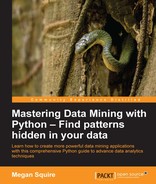In this chapter, we learned the basics of network analysis and graph theory, including how to measure a network and describe its properties. We learned why the degree, distance, and centrality of a network are important. We also investigated the various graph data formats that are used in network analysis, and considered which ones are most effective for which types of graphs. Finally, we implemented a real-world project where we build networks of software developers that had worked together in the RubyForge ecosystem. We learned various techniques for exploring the networks, including how to build smaller and more detailed networks, and how to explore component subgraphs. We discovered a few techniques for focusing on a single node and building out ego networks, and eventually we implemented those ego networks into a view of a component and its change over time.
In the next few chapters, we will turn our attention to text mining. Specifically, in Chapter 5, Sentiment Analysis in Text, we will learn how to perform sentiment analysis on text. Sentiment analysis attempts to identify the mood or feeling found in a text or a collection of texts. Now that we understand the social structure of a group of developers, can we learn how they talk and how they feel?
